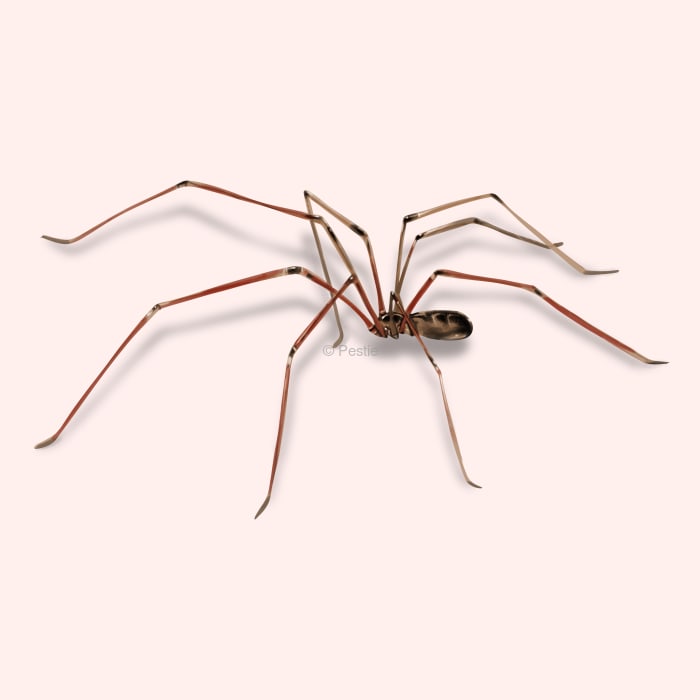How to identify and get rid of cellar spiders

Hiding in the corners: controlling and preventing cellar spiders
Ever wondered where those cobwebs keep coming from in your attic or basement? They aren’t catching flies and they don’t even look very organized. Well, that’s the way cellar spiders like their homes!
Cellar spiders are common household arachnids that set up shop in undisturbed corners of your home, including the attic, basement, sheds, or crawlspaces. While they aren’t poisonous or harmful, their webs can be a nuisance and make your home look a little untidy. Luckily, it doesn’t take much to remove these pests from your home.
How to identify cellar spiders
Cellar spiders are small arachnids with long legs, dangling from irregular webs up in undisturbed corners, windows, or doorways. Their small bodies and tan colors help them hide inconspicuously in dark places. Their frail legs are marked with dark joints, giving them a “knobby knee” appearance.
They also have the habit of vibrating their webs when alarmed, making them bounce and swing. They do this to blur their image, confusing predators and making them appear invisible.
How big are cellar spiders?
Even though their bodies are only about ¼ inch long, their legs can spread out to nearly 2 inches.
What other spiders look like a cellar spider?
Cellar spiders are sometimes called daddy-long legs and are confused with other critters with long legs. Harvestmen are also called daddy-long legs, but they aren’t spiders and don’t spin webs. Cellar spiders have a distinct separation in their two body parts, whereas harvestmen have the two segments fused into one.
Where do cellar spiders live?
Cellar spiders have a close association with human structures and prefer dark and humid areas. They can be found in attics, basements, garages, barns, sheds, or in the corners of eaves. These spiders are found on every continent except Antarctica.
How to get rid of cellar spiders
It’s not too difficult to get rid of cellar spiders if you are trying to tidy up. The biggest challenge might be trying to find them all. Cleaning up webs and egg sacs with a broom or vacuum is the easiest way to remove the mess.
Since cellar spiders won’t stay in areas that are frequently disturbed, dusting in corners, doorways, or windows can deter cellar spiders from spinning webs.
If you have high activity of cellar spiders in your home, there’s a good chance you have other insects in your home too. Sealing up cracks and gaps around your home, along with weatherstripping doors and windows can keep cellar spiders and their food source out of your home.
You can also spray an insecticide around or inside your home to keep spiders and other insects out. Pestie has a pro-grade DIY solution that is easy to apply and keeps you bug-free all year long.
Treat cellar spiders with Pestie
If you're still having trouble keeping cellar spiders away, the best option is to use a pro-grade, effective pest control solution like Pestie.
Pestie is a do-it-yourself pest control solution that's specially designed to keep cellar spiders and other pests away from your home.
With Pestie, you can rest easy knowing that your living space is protected and free of creepy crawlies. And the best part? It's designed for people, pets, and the planet, so you can say goodbye to harsh chemicals and hello to peace of mind!
- Save hundreds compared to traditional annual pest plans
- People, pet, and planet-friendly
- Pro-grade customized formulas
Quick facts
- Scientific name
Family - Pholcidae
- Other common names
Daddy Long-legs Spiders, Daddy Long-leggers, Carpenter Spiders, Vibrating Spiders, Gyrating Spiders, Long Daddy's, Skull Spiders
- Colors
Tan or gray
- Life span
2 years
- Diet
Small spiders and insects
How dangerous are Cellar Spiders?
Low danger risk
Cellar spiders are very common in homes throughout the US and they typically don’t bother people, their pets, or their stuff. They aren’t known to bite and don’t have very powerful venom.
Sometimes a cellar spider will invade the web of another spider and start vibrating, imitating the struggle of a trapped insect. When the spider comes to investigate, the cellar spider eats the host spider in their own web!








